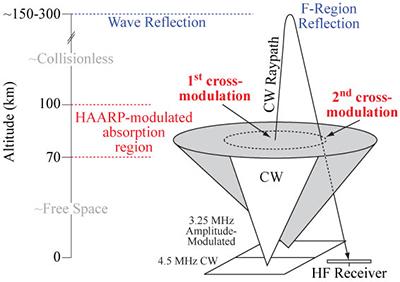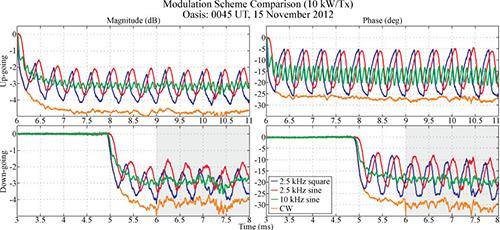Ionospheric Modification
While naturally occurring events can have a pronounced and long-lasting effect on the ionosphere, the term "ionospheric modification" specifically refers to changes in the ambient properties of the ionosphere that are produced by humans. Our working definition of "ionospheric modification" applies only to effects that can be repeated and controlled.
Ionospheric heating facilities broadcast high power radio waves typically in the HF band in order to modify the ionosphere in a controlled manner. HF heaters have been able to successfully reproduce several types of naturally occurring events: scintillation, electron density channels and layers, and airglow, among others. These HF heaters thus provide a controlled environment in which to study naturally occurring events.
A number of HF heating facilities exist around the world: HAARP (Alaska), EISCAT (Norway), Sura (Russia), Jicamarca (Peru), and the once-and-future ionospheric heater at Arecibo (Puerto Rico). Our work centers on experiments performed at HAARP.
Although the majority of ionospheric irregularities produced by HF heating occur in the E- and F-regions of the ionosphere, our primary interest lies in the highly collisional D-region ionosphere, located between 60 and 100 km altitude. The D-region is responsible for the vast majority of signal absorption that trans-ionospherically propagating radio waves experience, and the absorption process is highly nonlinear. Additionally, because the properties of the D-region ionosphere vary significantly with time, the level of absorption that radio waves experience is also highly variable. As a result, experiments aimed at quantifying the relationship between HF power and the occurence of a particular type of event require knowledge of D-region radio wave absorption.
One primary focus of our work at HAARP is to quantify the HAARP-modified HF radio wave absorption that occurs within the D-region ionosphere. We make use of a process known as HF cross-modulation, wherein a high power radio wave modifies the rate of absorption experienced by other HF waves propagating through the same volume. This phenomenon was first observed by Tellegen [1933], and explained appropriately by Bailey and Martyn [1934]. Figure 1 shows a cartoon diagram for a typical HF cross-modulation experiment, wherein the HAARP HF heating array radiates two distinct waves: a high-power radio wave that modifies D-region absorption, and a lower-power CW probing pulse that is used to quantify changes in absorption.
Langston and Moore [2013] showed that the HAARP-modified HF absorption can be easily quantified using HF cross-modulation experiments. Figure 2 presents amplitude and phase changes on upward- and downward-propagating HF waves imposed by a variety of modulated high-power radio waves. These absorption changes are significant (up to 5 dB and 30 degrees). In addition, the high time-resolution experiments performed yield exciting new results: the large and rapid phase changes can viewed as equivalent Doppler shift velocities (see Figure 3). This Doppler-spoofing on HF radio waves can be significant (60 km/sec) and important: some HF radars use Doppler techniques to determine the range and speed of targeted objects, indicating that their performance could deteriorate in the presence of these artificial ionospheric disturbances. By extrapolation, it is possible that natural ionospheric disturbances could also produce some level of Doppler-spoofing.




